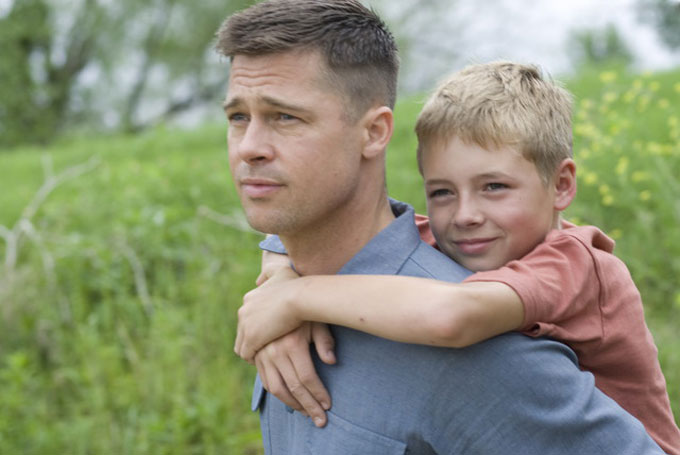The Tree of Life
by George Sax

Someone get the pruning hooks
The Tree of Life
The opening on-screen quote from the Book of Job ought to be a tip off: “Where were you when I established the foundations of the earth?” And soon afterward, Terrence Malick’s The Tree of Life takes us to that creational event, rendered in an explosive, fiery extravaganza. Malick’s ambition and means are certainly large scale and visionary. What they’re meant to communicate is considerably more difficult to say.
The Tree of Life actually begins in a more mundane setting than the beginning of the earth, a suburban Texas neighborhood sometime not too far in the past. (The film is rather vague about time frames and continuity.) The parents of a young man, the O’Briens (Brad Pitt and Jennifer Chastain), learn he has died, of what we’re not told. The information about this grievous loss is imparted by hushed indirection: a barely heard telephone call; a soft, almost whispered voiceover in what is apparently the mother’s voice. (She and her husband are never given first names.)
Then Malick sweeps us about as far backward as possible, to his spectacular Big Bang genesis, aided by both digital representations and Hubble telescopic photography. Flashing forward, he gives us glimpses of evolutionary progress, including a couple of prehistoric reptiles on the bank of a stream, perhaps the same one that the three O’Brien brothers will eventually play beside.
After this quick antediluvian run-through, Malick returns us to the O’Brien family. These montaged snippets and brief scenes don’t adhere to a narrative continuity. He has assembled his film in bursts of carefully composed shots and sequences, periodically interrupted by brief dramatizations, generally devoid of dialogue. There’s no real story; Malick employs narrative fragments and recurring dramatic devices. The sequences with the O’Briens and their town are presented in an almost dream-like fashion; there’s frequently an elegiac feel.
This may be at least partly explained, if these are as they seem to be the recollections of the eldest son, Jack (Sean Penn). There are recurring shots of him in and around a tall building amid the Houston skyline, looking sadly ruminative, perhaps because of the lingering effects of his younger brother’s death years before. (Penn’s role amounts to what may be the most striking under-utilization of a major screen actor in American film history.)
What Jack chiefly seems to be recalling is his long-ago troubled relationship with his rigid, sometimes overbearing and frustrated father, a man whose dissatisfaction with life can build to frighteningly angry outbursts. O’Brien is a resentful, vaguely Willy Loman-esque man who tells his affection-seeking eldest son (portrayed splendidly as a boy by Hunter McCracken) about the unfairness of life’s opportunities: “If you want to succeed, you can’t be too good.” Instructing his sons in pugilistic skills, he eggs them on to take a shot at him.
Malick isn’t telling a story here, he’s accreting details for a portrait, but the result doesn’t begin to cohere. O’Brien is at once a stern enforcer of petty deportment rules and a vulgar, unsuccessful seeker of commercial success, as well as a sensitive musician who plays his church’s organ and calls his son’s attention to the glory of Brahms. Pitt has worked hard within the real limitations of the material and the director’s methods, but the picture doesn’t add up, and neither does the film around it. The Tree of Life is a grandiloquent jumble.
And yet there are things in this muddled work that engross and seep into one’s consciousness, primarily in the loosely knit serious of shots and passages of small town life, perhaps the best I’ve ever seen. Malick, his cinematographer Emmanuel Lubezki, and the film and sound editors have realized an experience of American streets and the life on and around them in rhythmically linked compositions that are deeply convincing and poignantly evocative. They’re nostalgic in feeling, but they do little to advance whatever it is that Malick wants to communicate.
It’s reasonably clear early on that he intended some kind of religious sentiment, if not quite a message. Over the early mournful suburban glimpses, the mother’s soft voice tells us, “There’s a way of nature and a way of Grace” and at the end, everyone is gathered in a vivid reconciliation on the seashore, a silent scene of allegorical transcendence. It’s often been said that Malick is a film poet. Newsweek’s David Anson called Malick’s famous 1978 formalist exercise, Days of Heaven—the film whose resounding popular failure sent him into a 20-year exile from filmmaking—“a tone poem.” But he’s a perversely obscure poet, one obsessed with technique and visual effects. The lyricism with which he’s imbued The Tree of Life doesn’t sustain enough meaning and interest. The film seems designed like a musical composition, a dense series of variations on a theme Malick never really establishes.
Watch the trailer for The Tree of Life
blog comments powered by Disqus
|
Issue Navigation> Issue Index > v10n25 (Week of Thursday, June 23) > Film Reviews > The Tree of Life This Week's Issue • Artvoice Daily • Artvoice TV • Events Calendar • Classifieds |









 Current Issue
Current Issue